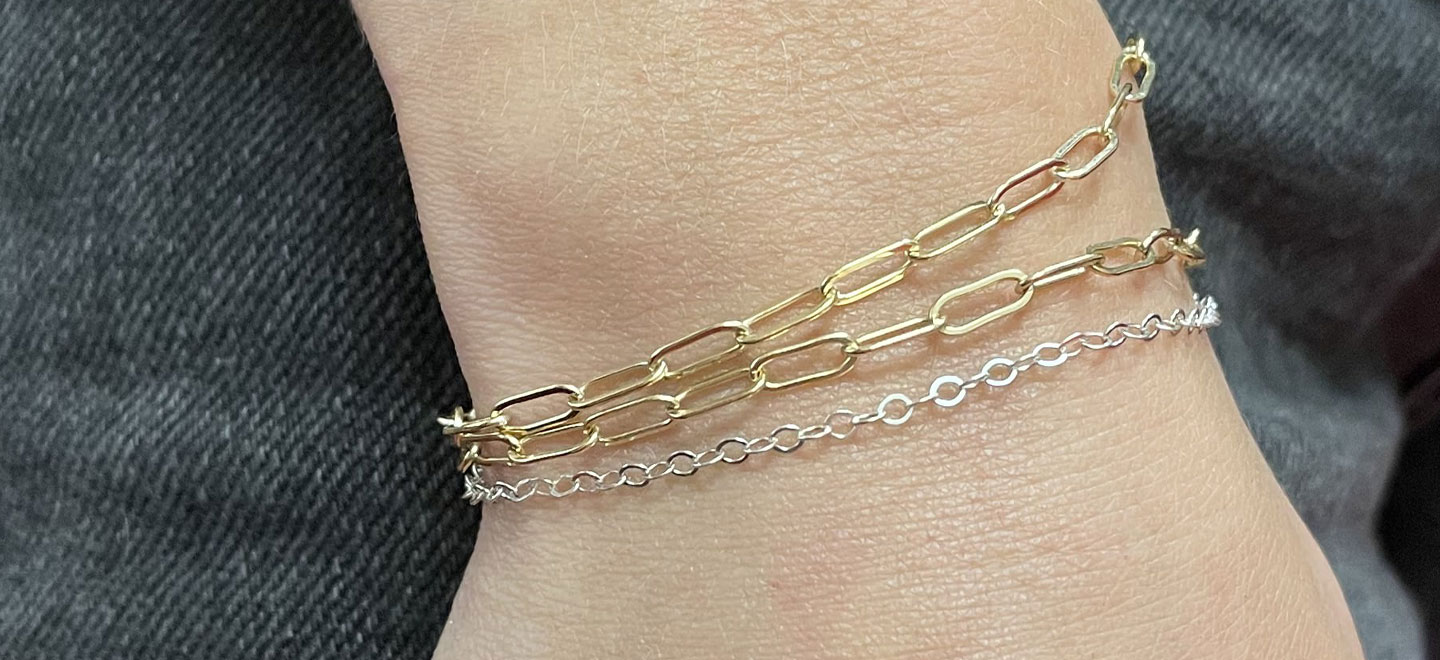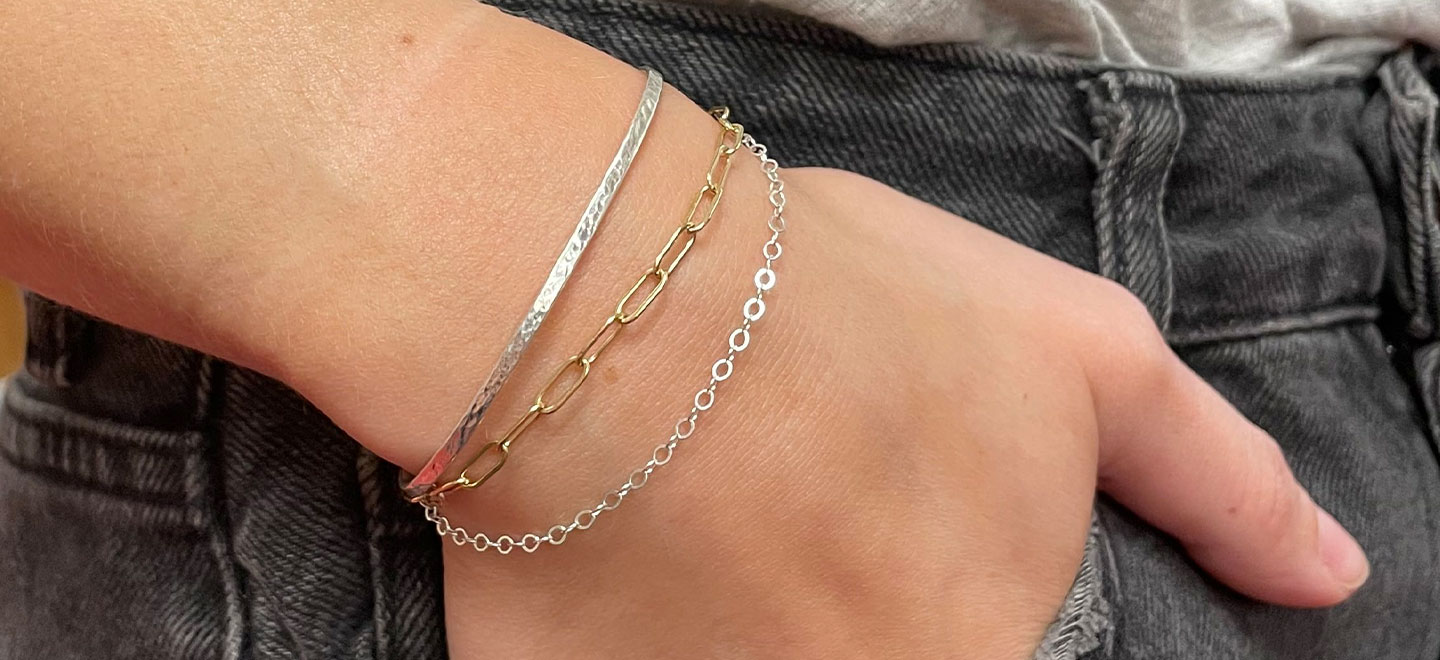Permanent bracelets have taken off! Easily add this fun experience to your jewelry business offerings with these tips.
Top 6 Tips for Safe, Happy Customers
Before we get into the nitty gritty of what 'permanent' jewelry is and important things to know before you get started, here are a few tips to ensure your welded jewelry biz is a success!
1. Use lightweight chains for safety
Imagine snorkeling and catching an anklet on a corral reef. Imagine rock climbing and slipping down a crag that wedges your bracelet into a crack. Imagine dropping a power tool and catching your chain in the motor. These are all examples of common activities where you would typically remove your jewelry. “Permanent” jewelry clients should be advised not to engage in sports or activities where injuries may occur from catching a chain. Unfortunately, consumers often ignore product instructions. So, for safety reasons, it is important to only weld lightweight chains that will break under circumstances like these to prevent major injuries. Breaking at certain stress levels, protects the body from serious wounds, broken bones, or worse. Your best options are narrow gauge cable chains or alternating link styles that have narrow gauge smaller links. Heavier chain bracelets should always have clasps instead of welded connections.
2. Never weld necklaces
Necklaces are at a vulnerable point on the human body. Never ever weld a chain on the neck. In the 1980s, there was a rash of serious injuries around the US because of a wave of petty theft. Criminals would run by victims and snatch the gold chains off their necks. The expectation was that the chain would break and the thief could get away with the gold scrap value. In response, some jewelry stores started soldering jump rings onto heavy duty clasps to prevent theft. These chains would not break when grabbed, but the strategy was short-sighted. Horrific injuries occurred during attempted robberies when customers were yanked by the neck. Reconsider some of the scenarios in the previous section and what would happen if the snags occurred with a necklace. Never weld on the neck, even fine-gauge cables are too dangerous.
3. Never weld jewelry on children
Children play and sometimes do silly things. They are not capable of understanding and following safety guidelines. It is inappropriate to weld jewelry onto a child, even when a parent requests the service.
4. Precious metals are not like steel
It is important to provide information about materials since consumers often do not know much about precious metal alloys. The popularity of body jewelry and piercings has shifted consumer expectations. Many people now assume all metals are like the surgical steel used in piercings. That is simply not true. Silver and gold are softer, more malleable metals than steel. They can scratch, bend, break, and stretch. These are normal limitations of the metals, not defects or signs of poor quality. They can also get dirty or tarnish. They will require care and cleaning to last. The old rule for jewelry was that it should be, “the last thing you put on, and the first thing you take off.” This was to protect jewelry from exposure to chemicals in cosmetics, hair care products, perfumes etc; all of which are bad for precious metals. Consumers need to be educated to avoid slathering lotions or sunscreen onto jewelry or soaking in hot springs. Chemical exposures such as these can discolor jewelry. Regular cleaning and maintenance may be needed.
5. Set expectations for “permanence”
The term “permanent jewelry” caught on very quickly with the welded bracelet trend. It is important to set realistic expectations for customers when they purchase a “permanent” jewelry piece. They need to understand the limitations of the materials they select for their bracelets. Regular care and cleaning will still be required. Bracelet links cannot withstand any and all stressors. Communicate clear expectations with your repair and replacement policies. If you are offering any kind of guarantee, specify the maximum number of months or years after purchase. At Halstead, for example, our return & defect policy only covers 30 days after purchase.
6. Yes, metal can get wet but…
Metals can get wet without damaging the integrity of the material. Swimming and bathing will not harm metal items. However, be careful with the term “waterproof.” This word is used to describe products that have been treated to prevent water from contacting the surface or for products with compartments that need to be sealed off from water penetration. It is not a term used in the jewelry trade. Also, note that water itself does not damage or react with metals; but, chemicals in water and commonly used beauty products can react with metals with repeated exposure over time.
What is an Infinity Bracelet?
Infinity bracelets are also called 'permanent' bracelets because you fuse the chain together around the customer's wrist to their exact size. There is no clasp on these bracelets! If a customer needs to take the metal off, they'll need to snip the connection and come back in for a reconnection if they'd like. These welded bracelets have become a great experience outing for friend groups or couples to come in and get matching jewelry sets.

What Do You Need?
To offer this experience, you'll need to invest in a pulse arc welder. This welder releases a concentrated pulse of energy to heat up the metal on the chain. It's important to note that this tool requires the use of argon gas. Argon gas is safe and non-flammable, but very important to the strength of your weld. Welding without the gas creates a brittle weld that doesn't bond properly. You can get argon gas from your local welding supply store.
Since these bracelets are meant to be long lasting, you want to make sure you have high quality jewelry chain that can stand up to everyday wear without worrying about breakage or reactions on your customer's skin. However, you also want to stick with a thinner chain to avoid overheating the metal and burning the wrist. We put together a sterling silver and 14k gold permanent jewelry starter kits to set you up with the right sized materials perfect for permanent jewelry. Wondering why we don't have a gold-filled starter kit? That's because we don't recommend gold-filled for 'permanent' jewelry. Gold-filled is a layered product, meaning there's a layer of gold bonded to jewelers brass, and it was designed for traditional jewelry wear. 'Permanent' jewelry exposes metal to more extreme conditions; including repeated contact with lotions, soaps, and chemicals that can induce tarnishing. Gold-filled chains will have a solder joint on every link from the production process. This spot is more susceptible to tarnish than the rest of the chain. If you get dark spots on your gold-filled chains it's likely tarnish at the solder joint, not a defective or low-quality product. It's because of reasons like these that we only recommend sterling silver and 14k gold. Your client will have a longer lasting bracelet with these materials.
Check out all of our recommended products for 'permanent' jewelry. We carry a variety of charms and chains in sterling silver and 14k gold that are perfect for your permanent jewelry customers. SHOP PERMANENT JEWELRY SUPPLIES >>
Setting Expectations
Be sure to talk your clients through the realities of welded jewelry. The key to a good customer service relationship is communications to set clear expectations about normal jewelry issues. Here are key concerns to cover verbally during your consultation and in your written service agreement:
- 'Permanent' jewelry is not recommended for people who regularly engage in activities where snags could lead to injury. Consider sports, hobbies, tool & equipment use when making this decision.
- Point out that certain charm and link styles are more likely to catch on things. Watch for points and sharp angles that can hook fabrics, for example. Simple chains will wear the best over time.
- Precious metals are malleable. If bracelets get caught on something and tugged, links can stretch, bend, or break altogether. 'Permanent' bracelets are delicate by design so they are light and comfortable to wear.
- Clarify your repair and replacement policies. Make sure customers understand when there will be additional charges.
- If a customer needs to cut off their bracelet, they should know the best place to do so and the tools you recommend. Spell out your fee structure to re-weld or add a clasp to the bracelet.
- Sterling silver will tarnish over time. This is a normal reality of the metal. Provide instructions to safely clean the jewelry. Or offer removal and cleaning service options through your business.
Although we don't recommend using gold-filled for welded jewelry, we know many people do. It's critical you communicate to your client the risks associated with gold-filled. This means setting realistic tarnish and wear expectations, and discussing how gold-filled chains are made. It's a good idea to include this information in your written agreement as well.
How to Make a 'Permanent' Bracelet
You'll want to measure the chain against your customer's wrist as close as possible without being too tight. The chain should be able to wiggle a little bit. Snip the chain. To create a more seamless look, try cutting the link of the chain to fuse together. Alternatively, you can slip a jump ring in and fuse that. Try SJ33 or KT243 for the perfect fit! Use your pulse arc welder to quickly and carefully fuse the metal together according to the welder's instructions and safety manual.

We Do Not Recommend Gold-filled for 'Permanent' Jewelry
We don't recommend gold-filled for 'permanent' jewelry because it is not a solid alloy, but layered. This means over time the gold layer can wear off, exposing the brass underneath. Gold-filled is more susceptible to tarnishing than solid gold. If tarnish gets in between the layers, you cannot remove it like you can with sterling silver or solid 14k gold. Gold-filled cannot withstand constant and prolonged exposure to skincare products and other compounds with high sulfur content. The next section explains how these products can affect your jewelry. Learn more about gold-filled by reading some of our other articles.
What You Should Know
You should also pay close attention to the safety warnings associated with your pulse arc welder to ensure you and your customers do not get injured. Keep in mind that although it's possible to create a 'permanent' necklace or anklet, by nature these may be more prone to breaking based on the location of the jewelry.
Keep in mind that with constant daily wear, your sterling silver chain is likely to be exposed to materials that can cause tarnishing. This includes beauty products that may have sulfates (such as hairspray, shampoo, lotion, etc.), chlorine, rubber, leather and more. Make sure your customers understand that if their jewelry comes into contact with these products they should take extra care to clean their chains to avoid tarnishing. Welded jewelry requires maintenance and will have limits on what it can stand up to. This relates to where you store your materials and do your welding also. Be sure to protect your chains from the chemicals in hair and nail salons. Exposure to these fumes and products will cause your chains to tarnish before they’re even worn. Be sure to have a designated welding area away from any of these contaminates and be sure to store your materials in a safe place.
What Not To Use In 'Permanent' Jewelry
Since 'permanent' jewelry will be worn all day, every day, through all conditions it's important to use jewelry supplies that will hold up to everyday wear. There are a few things we'd recommend avoiding when adding 'permanent' jewelry to your collection. Pearls and stones other than diamonds or sapphires/rubies may not hold up to everyday wear. If you want to include stones in the jewelry, we'd recommend ones with a Mohs hardness of 9 or 10. Gold plated charms have a thinner layer of gold and will wear faster than solid gold or gold-filled. Enameled charms are also not recommended as they are likely to chip with constant, everyday wear. Avoid anything porous that would get too dirty and wear down. And finally, if a 24 gauge jump ring won't fit through the chain link, switch to a chain with larger links. Do not stretch the links as this creates a weak spot that is more likely to break.

Jewelry Welding Agreements
We suggest having your customers sign an agreement understanding the risks of welded jewelry. Overall, jewelry is not made to be worn all the time, so be sure to communicate the risks that come with this. Discoloration or tarnishing, the bracelets snapping off or getting damaged are all risks associated with wearing something all the time. Have a replacement or re-weld policy in place if this does happen, or if your customer needs to remove it themselves for any reason. It makes sure you and your customers are on the same page before welding, and there are no misunderstandings later on. You may choose to include a care card as well. This can talk about best cleaning practices, products to avoid, and more, to ensure your customers take the best care of their jewelry possible.
'Permanent' Jewelry Starter Kits
Check out our Sterling Silver Permanent Jewelry Starter Kit and our 14k Gold Permanent Jewelry Starter Kit for an all-in-one 'permanent' jewelry starter kid. The sterling silver kit includes chains, charms, and jump rings for approximately 12 bracelets. The 14K gold kit includes chain, jump rings, and charms for about 3 bracelets and is a great way to introduce gold to your clients without spending a fortune.
Have questions about what may or may not work for welded jewelry? Reach out to us at [email protected] and we'll be happy to help you figure out if a particular chain will work!
Check out these related articles:
Untangling Jewelry Chain: Tips, Tricks & More





